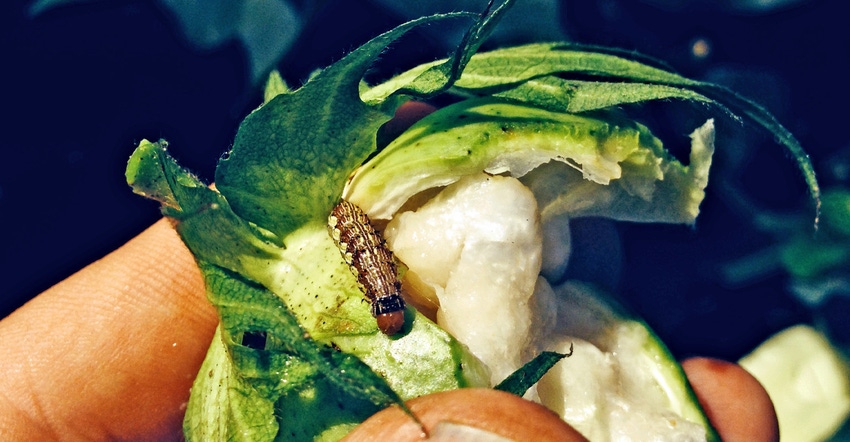
Bollworm resistance to early generations of Bt cotton, the Cry proteins, is becoming “widespread throughout much of Texas and across the U.S. Cotton Belt,” says David Kerns, statewide IPM coordinator and associate entomology department head, Texas A&M AgriLife Extension.
Kerns, speaking at the recent Texas Plant Protection Association annual conference, held virtually this year because of Covid-19, said genetics plays a role in resistance.
“Currently we have essentially four Bt proteins available in cotton, Cry1As, Cry2As, Cry1F and Vip3Aa.” Kerns said.
 David Kerns, statewide IPM coordinator and associate entomology department head, Texas A&M AgriLife Extension. (Photo courtesy of Texas A&M AgriLife Extension)
David Kerns, statewide IPM coordinator and associate entomology department head, Texas A&M AgriLife Extension. (Photo courtesy of Texas A&M AgriLife Extension)
He said multiple genes or a single gene may be driving the resistance issue, depending on the Bt protein. “Cry1A resistance is complex and appears to involve multiple genes, but there may be a single gene driving most of it. The Cry1A resistance appears to be incompletely to nearly completely dominant, but looks functionally completely dominant in the field. Cry2 resistance involves multiple genes, is incompletely dominant to incompletely recessive, depending on the Cry2 dosage.”
He said Vip cotton technologies “remain quite effective,” but does point to some resistance concerns.
“We may have several types of Vip3A resistance,” he said. “The form we see in the field appears to be a low level of resistance or may be natural variation in susceptibility. We have detected a form of Vip3A resistance, however, that renders the bollworm immune to Vip3A. This resistance is controlled by a single recessive gene.”
He said low levels of resistance to Vip have shown up in corn. “I’m not sure we even want to call it resistance,” he said.
“We are seeing a high level of resistance to Cry toxins. In fact, in 2020 we hit 100% Bt resistance.”
Kerns said the Bt varieties still have a place in cotton production but likely will require insecticide applications. “We do see a yield response when we sprayed BollgardII. “Prevathon and Besiege, work very well and Intrepid Edge worked well this year. Pyrethroids have been relatively ineffective in our area, due to resistance.”
Kerns said evaluations of fleahopper populations and insecticide application thresholds indicate “for every 1% of fleahopper population increase, we see a 2.65% reduction in lint. We can use this data to calculate application thresholds.
“Economic thresholds are coming in a lot lower than I anticipated, and vary depending on how much is spent to control them. With one insecticide application, thresholds are 4% to 5 %. With three applications, that moves up to 13%. In the Brazos Valley, we recommend a 10% to 15% spray threshold.”
Kerns also commented on a new Bt product, ThryvOn, in the pipeline from Bayer. “It is fantastic on thrips,” he said. “ThryvOn will be a game changer, and once it’s available we will never have to treat for thrips again.”
It’s helpful with fleahoppers but is not completely effective. “We see no dramatic effect on the fleahopper population,” he said. “We have seen an impact on square set. We see an apparent benefit on square retention and harvestable boll count.”
About the Author(s)
You May Also Like






